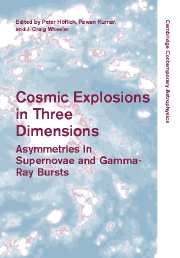Book contents
- Frontmatter
- Contents
- Part I Introduction
- Part II Supernovae: Observations Today
- Part III Theory of Thermonuclear Supernovae
- Part IV Theory of Core Collapse Supernovae
- Part V Magnetars, N-Stars, Pulsars
- Part VI Gamma-ray Bursts
- 36 GRB 021004 and Gamma-Ray Burst distances
- 37 Gamma-Ray Bursts as a laboratory for the study of Type Ic supernovae
- 38 The diversity of cosmic explosions: Gamma-Ray Bursts and Type Ib/c supernovae
- 39 A GRB simulation using 3-D relativistic hydrodynamics
- 40 The first direct Supernova/GRB connection: GRB 030329 / SN 2003dh
- 41 Gamma-Ray Burst environment and energetics
- Part VII Conference Summary
- References
39 - A GRB simulation using 3-D relativistic hydrodynamics
Published online by Cambridge University Press: 11 August 2009
- Frontmatter
- Contents
- Part I Introduction
- Part II Supernovae: Observations Today
- Part III Theory of Thermonuclear Supernovae
- Part IV Theory of Core Collapse Supernovae
- Part V Magnetars, N-Stars, Pulsars
- Part VI Gamma-ray Bursts
- 36 GRB 021004 and Gamma-Ray Burst distances
- 37 Gamma-Ray Bursts as a laboratory for the study of Type Ic supernovae
- 38 The diversity of cosmic explosions: Gamma-Ray Bursts and Type Ib/c supernovae
- 39 A GRB simulation using 3-D relativistic hydrodynamics
- 40 The first direct Supernova/GRB connection: GRB 030329 / SN 2003dh
- 41 Gamma-Ray Burst environment and energetics
- Part VII Conference Summary
- References
Summary
Abstract
We present the first unrestricted, three-dimensional relativistic hydrodynamical calculations of the blob of gas associated with the jet producing a gamma-ray burst as applied to the time when afterglow radiation is produced. Our main findings are that (ⅰ) gas ahead of the advancing blob does not accrete onto and merge with the blob material but rather flows around the blob, (ⅱ) the decay light curve steepens at a time corresponding roughly to γ˗1 ≈ θ (in accord with earlier studies), and (ⅲ) the rate of decrease of the forward component of momentum in the blob is well-fit by a simple model in which the gas in front of the blob exerts a drag force on the blob, and the cross sectional area of the blob increases quadratically with laboratory time.
Introduction
Gamma-ray bursts are the most powerful explosions in the Universe. If GRBs were isotropic, then the measured redshifts would imply total explosion energies of ∼1052–1054 ergs (Frail et al. 2001). Theoretical work on relativistic jet expansion, however, shows that one expects a steepening in the decay light curve if one is looking down the axis of a jet as the flow decelerates from a bulk Lorentz factor γ˗1 < θ to γ˗1 > θ, where θ is the jet beaming angle (Rhoads 1999). The concept of a “break” corresponding to γ˗1 ≃ θ has been used to infer the presence of strong beaming in GRBs (Frail et al.
- Type
- Chapter
- Information
- Cosmic Explosions in Three DimensionsAsymmetries in Supernovae and Gamma-Ray Bursts, pp. 346 - 350Publisher: Cambridge University PressPrint publication year: 2004



